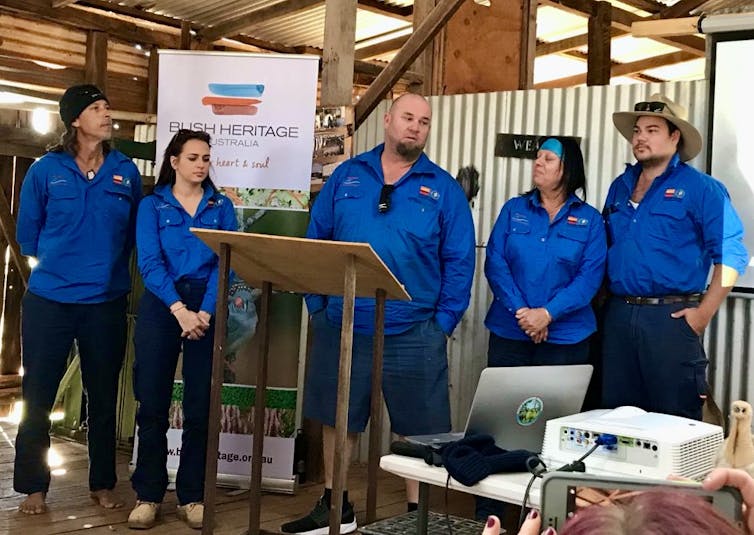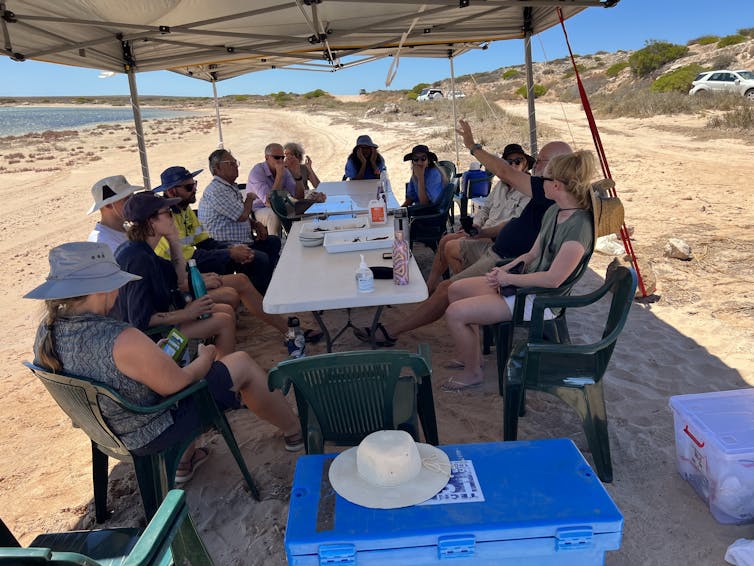Source: The Conversation (Au and NZ) – By Elizabeth Sinclair, Senior Research Fellow, School of Biological Sciences and Oceans Institute, The University of Western Australia
Please be advised that the following article contains images of an Indigenous person who has died, which are used with family permission.
Our journey began in 2018 at Bush Heritage Australia’s Hamelin Station, a relaxed setting on Malgana Country for knowledge sharing and storytelling. An inspirational weekend under the stars sowed the seeds for a partnership to heal Country. Our focus was on restoring seagrass, which grows in extensive meadows in shallow waters.
In 2010-11, an extreme marine heatwave had hit the Western Australian coastline. The seagrass (wirriya jalyanu) was badly damaged. This affected the health of culturally significant species such as dugongs (Dugong dugon, wuthuga) and green turtles (Chelonia mydas, buyungurra), which feed on the seagrass.
On that weekend in 2018, we (university researchers and Traditional Owners) learned we had a common goal: to look after Sea Country. Ecosystem restoration and biodiversity conservation are Western “science speak” and are part of a global solution to manage the impacts of climate change. These concepts are also at the core of Indigenous culture and lore.
Our co-designed project won funding to employ Malgana land and sea rangers in Gathaagudu/Shark Bay, a UNESCO World Heritage area. The project was a partnership between the newly founded Malgana Aboriginal Corporation and University of Western Australia researchers. The aim was to develop and test ways to restore seagrass meadows, drawing on both Western science and Indigenous knowledge.
Our new research paper describes how this partnership succeeded.

Elizabeth Sinclair, UWA, CC BY
‘Being on Country is medicine for us’
Our partnership recognised that Indigenous Peoples have deep ecological knowledge of Country. Malgana people shared their valuable insights on Sea Country.
Storytelling or songlines demonstrate a long oral history and connection of Malgana people to their Country. The stories are consistent with Western science-based knowledge from diverse fields such as ecology, geology, hydrology and molecular biology.
The partnership enabled trainee Indigenous rangers to return to Country. At the same time, they were able to gain industry qualifications through TAFE.
Knowledge-sharing workshops on Country helped Malgana rangers connect or reconnect with Country. The workshops covered cultural protocols, Traditional ecological knowledge, Malgana language, seagrass growth, flowering and seeding ecology.

Patricia Oakley, Malgana Elder
We also undertook research to understand relatedness, or genetics, of two large seagrasses, wire weed (Amphibolis antarctica) and ribbon weed (Posidonia australis), across Gathaagudu. DNA testing has shown an ancient ribbon weed clone is the world’s largest plant, spanning at least 180 kilometres. Our genetic study of wire weed is not yet published.
We developed restoration methods for both species. Our approaches took into account their different reproductive traits and genetic information.
Our restoration methods included planting cuttings or runners, sowing seeds and modifying the environment by providing hessian substrate for seedlings to attach.

Elizabeth Sinclair, UWA, CC BY
A Wirriya Jalyanu Festival marked the end of our project funding. Its theme was Art Meets Science. The festival shared knowledge of Sea Country through a mix of science, culture, language and artistic activities for all ages.
Sharing this knowledge with the wider community improved their understanding of this World Heritage area. We came away with a deeper understanding of their love and shared responsibility for its care.
‘If we look after country, then Country will look after you’
Partnerships that share Western and Traditional knowledge can restore seagrass meadows. The methods need to be scaled up to heal Sea Country, given the scale of loss caused by a single extreme climate event.
Local Indigenous ranger programs have environmental, cultural, social and economic benefits. Healing Country helps heal the intergenerational trauma of Indigenous Peoples through connecting or reconnecting to Country.
A next step is to empower the Malgana rangers and local Indigenous-led businesses to support and monitor large-scale ecosystem restoration and its impacts on biodiversity.
Continuous funding for these ranger programs is desperately needed to provide job security. Broadening partnerships with local rangers and communities allows for year-round observation and action On Country.
Since Europeans colonised Australia, Indigenous Peoples have been disrespected, which has contributed to enormous damage to our unique wildlife and ecosystems. The dynamic nature of these problems means we need diverse knowledge inputs. Partnering with local Traditional Custodians for two-way learning is a respectful way forward.
Western science and Traditional ecological knowledge together lead to a better understanding of Country. Applying these combined knowledges can increase biodiversity and help meet ambitious global solutions to climate change, such as the UN Decade on Ecosystem Restoration 2021-2030.
![]()
Elizabeth Sinclair receives funding from the Australian Research Council. This project was supported with funding from the Australian government under the National Environmental Science Program (NESP) Marine Biodiversity Hub and Marine and Coastal Hub.
Gary Kendrick receives funding from the Australian Research Council. This project was funded through the Australian government’s National Environmental Science Program.
Martin Breed receives funding from the Australian Research Council, National Environmental Science Program (NESP) Resilient Landscapes Hub, Cooperative Research Centre for Transformations in Mining Economies (CRC TiME), Australian Academy of Science, and the New Zealand Ministry of Business, Innovation & Employment.
Patricia Oakley is a descendant of the Malgana saltwater people from Gathaagudu (Shark Bay) and member of the Malgana Aboriginal Corporation (MAC) and MAC Elders Advisory Council, a senior ranger and a director on the MAC and Department of Biodiversity Conservation and Attractions Joint Management Body.
Sean McNeair works for Tidal Moon Pty Ltd and is a major shareholder since his resignation from Yamatji Marlpa Aboriginal Corporation (YMAC) as the MAC ranger co-ordinator (2018 to 2020). He is also affiliated with the Australian Marine Park Advisory Committee as a voluntary member and is a current official member of the Malgana Aboriginal Corporation (MAC) since native title determination in late 2018.
– ref. Healthy Country, healthy people: how shared knowledge is helping to restore a World Heritage area – https://theconversation.com/healthy-country-healthy-people-how-shared-knowledge-is-helping-to-restore-a-world-heritage-area-235776









